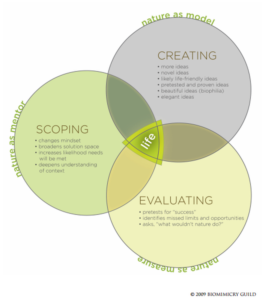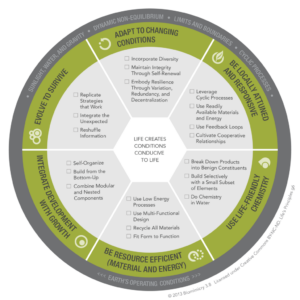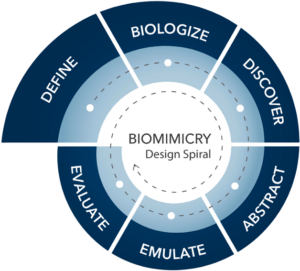All three “bioinspired designs” discussed in the previous post mimic nature in some capacity, but biomimicry takes on a more

Figure 1. Nature as a Model, Measure, Mentor
conscious approach. Biomimicry centralizes nonhuman nature as something to be respected, admired, and observed- not just used for parts. Rather, it uses nature as a model, measure, and mentor (see Figure 1).
There are countless examples of how we have used nature as a model (whether we gave ownership rights to the environment or not is a different story). For example, the kingfisher’s beak was modeled in the design of an improved bullet train (see “Contextualizing Biomimicry: Birds and Trains” blog post). To use nature as a measure, we can look to “Life’s Principles”- a list of principles recognizing
that Life on earth is “interconnected, interdependent, and subject to the same operating systems”. Biomimicry 3.8, the world’s leading bio-inspired consultancy, has embodied this technique as part of its DesignLens. Recognizing that “life creates conditions conducive to life” is the core theme in this design approach. Below is a list of nature’s 6 principles for sustainable design. [1]
Biomimicry 3.8’s “Life’s Principles”:
- Adapt to changing conditions
- Be locally attuned and responsive

Figure 2. Life’s Principles
- Use life-friendly chemistry
- Be resource-efficient
- Integrate development with growth
- Evolve to survive
For more details see Figure 2 and visit Biomimicry 3.8’s website.
Perhaps most importantly, biomimicry and “Life’s Principles” embrace that we are all part of the same system and that humans are not separate from or superior to nature. We must recognize our part in the system and work to maintain a balance for all life to thrive. Understanding and utilizing “Life’s Principles” in design can help us to do this. Lastly, biomimicry teaches us to view nature as a mentor by looking to nature as a guide and beacon of hope for developing sustainable innovation.
So how do we take the inspiration we gather from nature and translate it into ethical design? To perform a biomimetic design approach, the Biomimicry Institute provides “three essential elements”: Emulate, Ethos, and (Re)Connect. Below you can find the definitions as stated on the Biomimicry Institute website. [2]
The 3 Essential Elements of Biomimicry:
- Emulate– “The scientific, research-based practice of learning from and then replicating nature’s forms, processes, and ecosystems to create more regenerative designs.”
- Ethos– “The philosophy of understanding how life works and creating designs that continuously support and create conditions conducive to life.”
- (Re)Connect– “The concept that we are nature and find value in connecting to our place on Earth as part of life’s interconnected systems. (Re)Connect as a practice encourages us to observe and spend time in nature to understand how life works so that we may have a better ethos to emulate biological strategies in our designs.”
Understanding these elements is essential to maintain an ethical design approach that does not take advantage of nature as is common in industrialized societies. These elements require us to critically reflect on our connection to and position in the natural world. It ensures that we are not only emulating or copying nonhuman nature on the surface but modeling its circular systems. After understanding these elements, one can move on to the “Biomimicry Design Process”.
This design process allows an individual or team to apply biomimicry to any design challenge. These steps were curated by the Biomimicry Institute and are laid out below. [3]
The Biomimicry Design Process
- Define– “Clearly articulate the impact you want your design to have in the world (i.e., the challenge you want to solve) and the

Figure 3. Biomimicry Design Spiral
criteria and constraints that will determine success.”
- Biologize– “Analyze the essential functions and context your design solution must address. Reframe them in biological terms, so that you can ‘ask nature’ for advice.”
- Discover– “Look for natural models (organisms and ecosystems) that need to address the same functions and context as your design solution. Identify the strategies used that support their survival and success.”
- Abstract– “Carefully study the essential features or mechanisms that make the biological strategies successful. Restate them in non-biological terms, as ‘design strategies.’”
- Emulate– “Look for patterns and relationships among the strategies you found and hone in on the key lessons that should inform your solution. Develop design concepts based on these elements.”
- Evaluate– “Assess the design concept(s) for how well they meet the criteria and constraints of the design challenge and fit into Earth’s systems. Consider technical and business model feasibility. Refine and revisit previous steps as needed to produce a viable solution.”
Using biomimicry in the way Janine Benyus, the Biomimicry Institute, and Biomimicry 3.8 intend can help us to develop sustainable and restorative solutions and move beyond the “industrial age to an ecological age” [4]. Benyus and the organizations she has founded have been essential to the biomimicry movement. However, as with any concept, it is important to take a step back and seek out multiple perspectives from different voices. In future posts, I will discuss scholarly articles that call into question biomimicry’s impact on society and sustainability. These posts will explore how biomimics’ intent may not match their impact and why employing an iterative design approach is necessary.
References:
- “DesignLens: Life’s Principles” by Biomimicry 3.8: biomimicry.net/the-buzz/resources/designlens-lifes-principles/
- “What is Biomimicry” page on Biomimicry Institute website: org/what-is-biomimicry/
- “The Biomimicry Design Process” accessed through the Biomimicry Toolbox: toolbox.biomimicry.org/methods/process/
- “The Lotus Flower: Biomimicry Solutions In The Built Environment” (2015) article by Y. Nanaa, H. Taleb: witpress.com/elibrary/wit-transactions-on-ecology-and-the-environment/193/33918